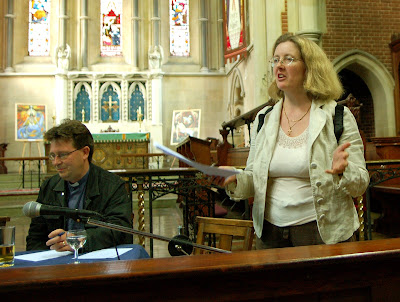 The panel for the evening - Mark Lewis, Rosalind Hore and Jonathan Evens
The panel for the evening - Mark Lewis, Rosalind Hore and Jonathan Evens  Rosalind Hore
Rosalind Hore Mark Lewis
Mark Lewis Jonathan Evens
Jonathan Evens Peter Webb & Mark Lewis in discussion
Peter Webb & Mark Lewis in discussion Michael Creasey & Rosalind Hore
Michael Creasey & Rosalind Hore Viewing the exhibition
Viewing the exhibition Viewing the exhibition
Viewing the exhibitionViewing the exhibition
Last night's Art & Spirituality networking evening proved an intriguing and stimulating event as we considered the question, 'Spirituality - the heartbeat of Art?'.
Helen Gould, Refresh Project Development Worker, opened the event by welcoming us to St Andrews Leytonstone. The church has a 123 year old history and art has been an indelible part of the buildings life. This event and Commission For Mission's exhibition are launching a creative programme – Reflect – which will run alongside their newly opened café, Refresh. Their intention is to offer a spiritual haven to the local community. As a result, the church has been exploring again how to work with art and how it fits with their Anglo-Catholic tradition.
Helen suggested that God's creativity could be the starting point for that exploration with our hunan creativity understood as being one of ways in which we are made in the image of God. She noted that even John Calvin had acknowledged the Arts as a gift from God. Among the benefits that use of the Arts can bring to churches are the exploration of difficult issues, the revitalisation of worship, and the sense of being brought closer to the Creator God.
The evening continued with presentations from three Commission For Mission artists:
- Rosalind Hore - a sculptor and painter of Christian subjects – Christ figures, nativity sets, Ecce Homo, Stations of the Cross etc. Rosalind works in clay, plaster, concrete (figures can also be bronze cast at the foundry). Her paintings are mostly in acrylic of the events in the life of Christ. Rosalind spoke about her work as the exaggeration of emotion. She reflected on the way in which the medium affects the means by which she conveys emotion; working in clay affords more detail, while working in plaster or concrete requires sweeping lines and folds. She also described her functional work for church festivals and the way in which worship often inspired images and new work.
- Mark Lewis - an artist, silversmith, Arts Lecturer at London Metropolitan University and Chair of Faith & Image. Mark has undertaken drawing and painting in a Christian context and has designed and made Church plate. In addition to his lecturing, Mark has delivered workshops for The Big Draw as part of its national launch. Mark spoke about spirituality in art as a sense of aliveness. He highlighted the very different work of Mark Rothko and Stanley Spencer, speaking about the sense of contemplation induced by Rothko's work and the sense of heaven in the ordinary in Spencer's. In speaking of his own work he described his sense of absorption in and fusion with the work as a spiritual experience.
- Jonathan Evens - paints in a symbolic expressionist style and has facilitated the involvement of churches in a range of public art projects. Jonathan's arts journalism has featured in publications including 'Art & Christianity' and 'The Church Times'. He is also a creative writer (meditations, poetry, short stories, and a blog) and the Vicar of St John the Evangelist Seven Kings. Jonathan is the Secretary of Commission for Mission. Jonathan argued that, despite a reluctance among art critics and tutors to note or engage with religious themes and imagery, there is nevertheless a prevalence of religious themes and imagery to be found in modern and contemporary art. He gave a brief and partial alternative history of modern and contemporary art to illustrate this argument and to suggest that this prevalence of themes and images does suggest that spirituality remains a significant inspiration of art.
Their three presentations will be the subject of subsequent posts and led on to vigorous debate which covered the following issues:
- the extent to which spirituality should be the starting point for an artist's work or conversely whether spirituality could emerge from the artist's handling of form;
- the extent to which non-religious themes can convey a sense of spirituality;
- the extent to which traditional religious iconography still connects with the general public or whether artists should seek to create new imagery and forms for the truths of their faith;
- the extent to which the artist bears the potential audience for the work in mind while creating or is absorbed in the work itself without consideration of outside influences;
- the extent to which it is better to display spiritual art within churches or out in the public realm;
- ways of countering the perceived lack of interest or understanding of spirituality within the art world generally; and
- the need for examples of good practice and networks of artists with an interest in both art and spirituality.


No comments:
Post a Comment